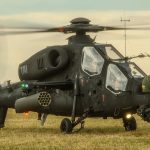Russian State-run media said fighters from the resistance groups, the Free Russia Legion and the Russian Volunteer Corps, were largely defeated in Belgorod on Tuesday.
This is just as the Pentagon is downplaying a Tuesday incident in which a Russian jet intercepted two U.S. bombers over the Baltic Sea, calling it “nothing significant.”
The Russian Ministry of Defense announced earlier Tuesday it detected two air targets approaching the country’s border and sent up a Su-27 fighter to investigate.
Meanwhile, around 70 militants were killed after Russia’s armed forces, Federal Security Service and border patrol agents cracked down on the resistance forces with the assistance of air strikes and artillery fire.
The pro-Ukrainian fighters had marched into Belgorod on Monday and claimed the liberation of two towns, Kozinka and Gora-Podol,before moving into Grayvoron.
After Russia invaded Ukraine last year, Belgorod has come under frequent bombardments. Until this week, however, the region bordering Ukraine has never seen a large contingent of pro-Ukrainian troops move into local towns.
Mark Hertling, a retired former commanding general of the U.S. Army in Europe, said he believed the incursion was a strategic raid designed to distract, spook and send a message to the Kremlin.
“There may be other such raids/feints/demonstrations to gather more information about Russian force dispositions and reinforcement priorities,” Hertling predicted on Twitter.
Several Russian civilians have been injured in Belgorod and at least one person died during an evacuation, according to the regional governor, Vyacheslav Gladkov.
Gladkov said at least 100 civilians were evacuated from towns and areas but later on Tuesday said residents were slowly returning to their homes and crucial services like electricity were being restored.
Both the Free Russia Legion and the Russian Volunteer Corps were formed last year, made up of defecting Russians who wished to defend Ukraine.
In social media posts and videos posted online, the Free Russia Legion said they were revolting against widespread corruption under Russian President Vladimir Putin and seeking to overthrow his regime.
Ukrainian officials have denied any involvement in the resistance groups in Belgorod, though they have welcomed their efforts.
In the intercepts of two U.S. bombers, the National Defense Control Center of the Russian Federation said in a statement on Telegram: “The crew of the Russian fighter classified the air targets as two U.S. Air Force B-1B strategic bombers and occupied the established air watch zone.”
Pentagon Press Secretary Brigadier General Pat Ryder later confirmed the incident to reporters.
“My understanding is that it was a safe and professional interaction with Russian aircraft. So nothing significant to report on that front,” Ryder said.
Asked where the incident took place and what specific aircraft were involved, he referred questions to U.S. European Command.
“As the Pentagon Press Secretary, Brig Gen Patrick Ryder, said during his news briefing today, two U.S. B-1 bomber aircraft operating in Europe as part of a scheduled bomber rotation were interacted with safely and professionally by Russian aircraft. At this time, we have no additional details to add,” U.S. European Command said in an emailed statement.
This isn’t the first interaction between U.S. and Russian aircraft over the Baltic Sea, but Moscow’s ongoing war in Ukraine has kept tensions high between the two countries and stoked fears that such incidents could lead to a wider escalation.
Those tensions reached a fever pitch in March when Russian jets damaged a U.S. MQ-9 in international airspace over the Baltic Sea, causing the drone to crash into the water.
The Biden administration and lawmakers admonished Moscow for what they called an unprofessional and unsafe maneuver, but no further conflict came of it.
There have also been several intercepts between U.S. and Russian aircraft near Alaskan airspace so far this year.





